 W
WThe Agha Mikayil Bath was erected in the 18th century in the south-western part of the fortress, on one of its main streets, Kichik Gala, Old City where local people frequently call this place the neighborhood of bath amateurs.
 W
WArran carpets are a carpet variety of carpets of the Karabakh carpet type.
 W
WAzerbaijani carpet weaving is a historical and traditional activity of the Azerbaijani people. The Azerbaijani carpet is a traditional handmade textile of various sizes, with dense texture and a pile or pile-less surface, whose patterns are characteristic of Azerbaijan’s many carpet-making regions. Carpet making is a family tradition transferred orally and through practice.
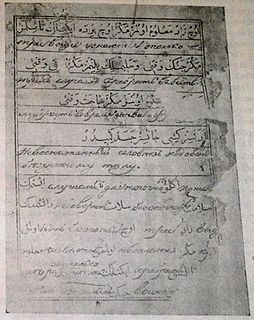 W
WAzerbaijani literature is written in Azerbaijani, a Turkic language, which is the official state language of the Republic of Azerbaijan, where the North Azerbaijaini variety is spoken, and is the first-language of most people in Iranian Azerbaijan, where South Azerbaijani is spoken. While the majority of Azerbaijani people live in Iran, modern Azerbaijani literature is overwhelmingly produced in the Republic of Azerbaijan, where the language has official status. Three scripts are used for writing the language : Azerbaijani Latin script in the Republic of Azerbaijan, Arabic script in Iranian Azerbaijan and Cyrillic script in Russia.
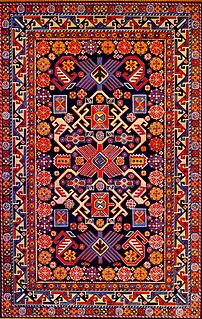 W
WAzerbaijani rugs are a product of Azerbaijan, an ancient center of carpet weaving. The Azerbaijani rug is a traditional handmade textile of various sizes, with a dense texture and a pile or pile-less surface, whose patterns are characteristic of Azerbaijan's many carpet-making regions. Traditionally, since ancient times the carpets were used in Azerbaijan to cover floors, decorate interior walls, sofas, chairs, beds and tables.
 W
WTea in Azerbaijan is served freshly brewed, hot and strong. It typically has a bright colour and is served in crystal or any other glasses or cups. Azerbaijanis often use traditional armudu (pear-shaped) glass. Tea is served continuously when there are guests or when there is an interesting conversation. For Azerbaijanis tea with milk is uncommon. According to a common belief, drinking tea with lump sugar instead of sand sugar comes from the medieval period, when rulers who were afraid of being poisoned checked their tea by dunking a piece of sugar in a beverage. Traditional tea is served with lemon, cube sugar, sweets and fruit desserts. Sometimes thyme, mint or rose water is added, which is believed to be good for the stomach and heart.
 W
WBakshaish rugs and carpets are a type of tapestry found in north-west Iran. Bakshaish, Heris County, is a town on the banks of the Aji Chay in the Heris region. Situated in the mountainous region 60 miles east of the large city of Tabriz, Bakshaish is the oldest rug weaving village in the district, noted for carpets with diverse abstract adaptations of age-old tribal and classical Persian motifs.
 W
WBazar square or Khanqah complex is a historic religious-architectural complex with arcade of XII-XIII centuries. It is a part of Old City and located on Kichik Gala street, in the city of Baku, in Azerbaijan. It was also registered as a national architectural monument by the decision of the Cabinet of Ministers of the Republic of Azerbaijan dated August 2, 2001, No. 132.
 W
WBukhara Caravanserai was erected in the late 15th century over a trade route passing through the Shamakhi Gates of the fortress. It is close to the Maiden Tower. The caravanserai was harnessed as a hotel, basically catering to merchants of Central Asia.
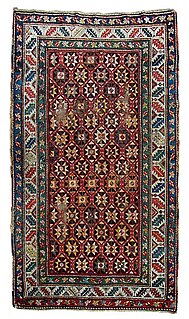 W
WGanja rugs or Geunge rugs are a category of Caucasian rug from the town of Gəncə, Azerbaijan, also written Geunge, Gendje or Ganja. Gəncə is located between the weavings areas of Karabagh, Kazakh and Shirvan and it also acted as a marketing centre for weaving from those surrounding areas.
 W
WGarghabazar caravanserai is a historic monument of XVII century. It is located in Garghabazar village, of Fuzuli District, in Azerbaijan.
 W
WThe Gasim bey Bath, built in the 17th century, is a medieval monument of national importance. Also named Sweet Bath for the sweets served to bathers with their tea, it is located near the Salyan gates of the fortress, Icheri Sheher, Azerbaijan.
 W
WThe Geysariyye Monument is a historical and architectural monument of the 17th century located in Ordubad, Nakhchivan Autonomous Republic. Situated at market square, the city center of Ordubad, it is one the Turco-Islamic monuments of Nakhchivan. Total area of Geysariyye is 540 m². It consists of a large dome and 16 small dome adjacent to it. The monument is made of baked bricks with a height of 8.5 meters. The windows of the historic building were developed with network method.
 W
WHeriz rugs are Persian rugs from the area of Heris, East Azerbaijan in northwest Iran, northeast of Tabriz. Such rugs are produced in the village of the same name in the slopes of Mount Sabalan. Heriz carpets are durable and hard-wearing and they can last for generations. 19th century examples of such carpets are often found on sale by major auction houses in United States and Europe. Part of the reason for the toughness of Heriz carpets is that Mount Sabalan sits on a major deposit of copper. Traces of copper in the drinking water of sheep produces high quality wool that is far more resilient than wool from other areas. The Heris Carpet is the only carpet in the world where stories of the Old times are woven.
 W
WHıdırellez or Hıdrellez is celebrated as the day on which the Prophets Hızır (Al-Khidr) and Ilyas (Elijah) met on Earth. Hıdırellez starts on May 5 night and falls on May 6 in the Gregorian calendar and April 23 in the Julian calendar. It is celebrated in Turkey. It celebrates the arrival of spring. People pray on this day whatever their wishes are. They make symbols with stone or draw of their wishes.
 W
WThe Icheri Bazar is located in the center of Qakh city, Azerbaijan. It was built in the first half of 18th century and was renovated by the Russians in the 19th century.
 W
WThe Karabakh carpet is one of the varieties of carpets of Transcaucasia, made in the Karabakh region of modern-day Azerbaijan. Karabakh carpet making was added to UNESCO's Representative Masterpiece of Intangible Heritage as part of Azerbaijani Carpets.
 W
WKaradagh rug or Karaja rug handmade in or near the village of Qarājeh (Karaja), in the Qareh Dāgh (Karadagh) region of Iran just south of the Azerbaijan border, northeast of Tabrīz.
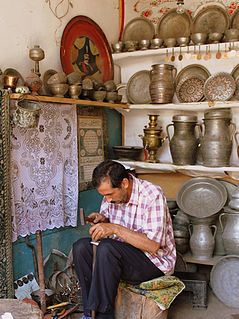 W
WLahıc copper craft is a traditional folk art of Lahıc, Ismailli in Azerbaijan. It includes the production of copper crockery and other products. It was added to UNESCO's Representative List of the Intangible Cultural Heritage of Humanity in 2015.
 W
WThe Land of Fire is the adopted motto of Azerbaijan.
 W
WTwo Cultural Heritages are listed as in Need of Urgent Safeguarding. These are Naqqali and "Traditional skills of building and sailing Iranian Lenj boats".
 W
WMaiden Tower is the first Azerbaijani ballet and the first ballet in the Muslim Eastern countries. It consists of three acts with a prologue and epilogue. Afrasiyab Badalbeyli is the author of the music and libretto.
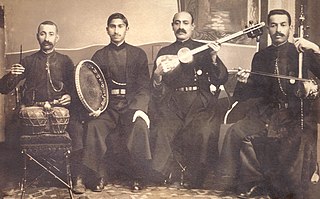 W
WMeykhana is a distinctive Azerbaijani literary and folk rap tradition, consisting of an unaccompanied song performed by one or more people improvising on a particular subject. Meykhana is distinct from spoken word poetry in that it is performed in time to a beat.
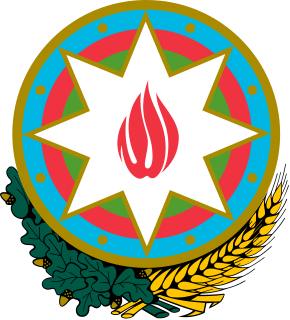 W
WThe Ministry of Culture of Azerbaijan Republic is a governmental agency within the Cabinet of Azerbaijan in charge of regulation of the activities and promotion of Azerbaijani culture. The ministry is headed by Anar Karimov.
 W
WMultani Caravanserai was established in the 14th century. It is opposite to the Bukhara Caravanserai.
 W
WAzerbaijani nationalism, also referred to as Azerbaijanism, started out as a cultural movement among Azerbaijani intellectuals within the Russian Empire during the second half of the 19th century. While initially cultural in nature, it was later developed further into a political ideology which culminated in the establishment of the Azerbaijan Democratic Republic in 1918.
 W
WThe Paired Fortress Gates or Gosha Gala Gapysy are one of the main entrances to the Icherisheher section of Baku, Azerbaijan. Until the end of the 19th century, the Shamakhi Gates had been the only entry to the fortress.
 W
WA Persianate society is a society that is based on or strongly influenced by the Persian language, culture, literature, art and/or identity.
 W
WA pictorial carpet, picture carpet, tableau rug, carpet tableau or rug tableau is an ornamental rug specially prepared for hanging on room and hall walls for decoration. The designs and samples on pictorial carpets are completely different from those on common floor rugs. Pictorial carpets are generally made of silk but they have also been made from wool. Pictorial carpets are usually framed to sell and use.
 W
WThere are several public holidays in Azerbaijan. Holidays were regulated in the constitution of Azerbaijan SSR for the first time on 19 May 1921.
 W
WQuadrangular tower or Keep of the fortress of Baku is a historic tower of XIV century. The tower is also referred as a keep. It is a part of Old City and located on Kichik Gala street, in the city of Baku, in Azerbaijan. The building was also registered as a national architectural monument by the decision of the Cabinet of Ministers of the Republic of Azerbaijan dated August 2, 2001, No. 132.
 W
WWheat sprout is a product of germinating wheat seeds in a wet and relatively warm environment in a process called sprouting. It is commonly known and used in Iranian cuisine. However, it is sometimes used instead of barley in the form of malt for making beer.
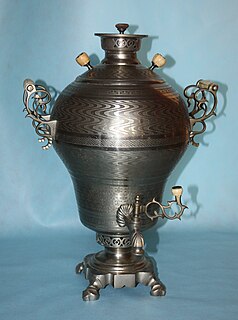 W
WA samovar is a metal container traditionally used to heat and boil water. Although originating in Russia, the samovar is well known outside of Russia and has spread through Russian culture to Eastern Europe, South-Eastern Europe, Iran, Afghanistan, the Kashmir region of India, the Middle East, Azerbaijan and is also known in some parts of Central Europe. Since the heated water is typically used to make tea, many samovars have a ring-shaped attachment around the chimney to hold and heat a teapot filled with tea concentrate. Though traditionally heated with coal or kindling, many newer samovars use electricity to heat water in a manner similar to an electric water boiler. Antique samovars are often prized for their beautiful workmanship.
 W
WShahsevan rug or Shahsevan Kilim is the Iranian Style, handmade by the Shahsevans in the Azerbaijan region of Iran.
 W
WThe Shamakhi dancers were the principal dancers of the entertainment groups that existed in Shamakhi up to the late 19th century. These groups worked similarly to tawaifs.
 W
WThe Small Cravanserai in Baku, Azerbaijan has a square shape and an inner quadrangular courtyard with cut corners. This caravanserai was built in the 12th century. There is a long balcony which surrounds the building of the caravanserai. The north and south entrances of the caravanserai are portal-shaped. During the Middle Ages, there was a main entrance from the sea. The caravanserai has a defensive construction and two floors on the southern side.
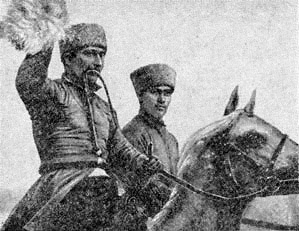 W
WSur-papakh is an Azerbaijani sport played on horseback.
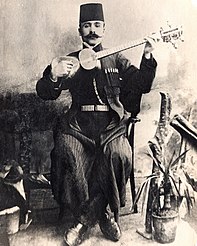 W
WThe Azerbaijani tar and the skills related to this tradition play a significant role in shaping the cultural identity of Azerbaijanis. The tar is a long-necked, plucked lute, traditionally crafted, and performed in communities throughout the Republic of Azerbaijan. The tar is featured alone or with other instruments in numerous traditional musical styles. It is also considered by many to be the country's leading musical instrument.
 W
WA tubeteika is a Russian word for many varieties of traditional Central Asian caps. Tubeteikas are today worn in Tajikistan, Kazakhstan, Kyrgyzstan, and Uzbekistan, as well as in Muslim-populated regions of Russia and Azerbaijan. The skullcap worn by Uzbeks and Uyghurs is called a doppa and has a square base. It was a popular headgear among children throughout the USSR during the 1940s and 1950s.
 W
WTurkic mythology features Tengriist and Shamanist strata of belief along with many other social and cultural constructs related to the nomadic existence of the Turkic peoples in early times. Later, especially after the Turkic migration, some of the myths were embellished to some degree with Islamic symbolism. Turkic mythology shares numerous points in common with Mongol mythology and both of these probably took shape in a milieu in which an essentially nationalist mythology was early syncretised with elements deriving from Tibetan Buddhism. Turkic mythology has also been influenced by other local mythologies. For example, in Tatar mythology elements of Finnic and Indo-European mythologies co-exist. Beings from Tatar mythology include Äbädä, Alara, Şüräle, Şekä, Pitsen, Tulpar, and Zilant. The early Turks apparently practised all the then-current major religions, such as Buddhism, Christianity, Judaism and Manichaeism, before the majority converted to Islam; often syncretising these other religions into their prevailing mythological understanding.
 W
WTwo-storeyed or Gasim bey caravanserai is a historic monument of the XV century. It is a part of Old City and located on Hagigat Rzayeva street, in the city of Baku, in Azerbaijan. The building was also registered as a national architectural monument by the decision of the Cabinet of Ministers of the Republic of Azerbaijan dated August 2, 2001, No. 132.
 W
WUzeyir Hajibeyov's House Museum is the house in which the famous Azerbaijani composer Uzeyir Hajibeyov lived, located on Shamil Azizbekov Street near the Nizami metro station. The museum was created to perpetuate and propagate the life and work of composer Uzeyir Hajibeyov. The Memorial Museum is under the control of the Ministry of Culture and Tourism of the Republic of Azerbaijan.
 W
WThe Azerbaijani wedding tradition is one of the most significant and solemn family traditions in the Azerbaijan Republic and Iranian Azerbaijan region, where majority of Azeris live. It is multi-stepped, and is related to various compulsory rituals and traditions. Ancient Azerbaijani weddings reflect cycles of traditions, lasting for a long period of time, and need significant material costs.